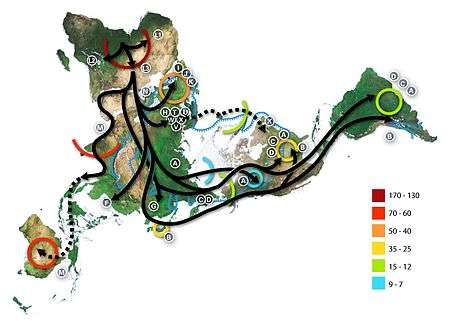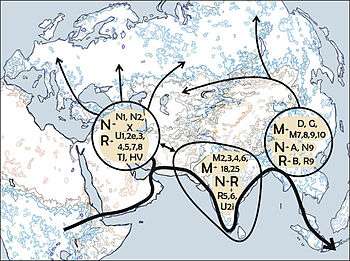Human mitochondrial DNA haplogroup


In human genetics, a human mitochondrial DNA haplogroup is a haplogroup defined by differences in human mitochondrial DNA. Haplogroups are used to represent the major branch points on the mitochondrial phylogenetic tree. Understanding the evolutionary path of the female lineage has helped population geneticists trace the matrilineal inheritance of modern humans back to human origins in Africa and the subsequent spread around the globe.
The letter names of the haplogroups (not just mitochondrial DNA haplogroups) run from A to Z. As haplogroups were named in the order of their discovery, they (meaning the accidental dictionary ordering of the letters) do not reflect the actual genetic relationships.
The hypothetical woman at the root of all these groups (meaning just the mitochondrial DNA haplogroups) is the matrilineal most recent common ancestor (MRCA) for all currently living humans. She is commonly called Mitochondrial Eve.
| Part of a series on |
| Genetic genealogy |
|---|
| Concepts |
| Related topics |
Evolutionary relationship
Lineage perspective
This phylogenetic tree is based on the Van Oven 2009 tree[1] and subsequent published research.
Table perspective
|
Phylogenetic tree of human mitochondrial DNA (mtDNA) haplogroups | |||||||||||||||||||||||||||||||||||||
| Mitochondrial Eve (L) | |||||||||||||||||||||||||||||||||||||
| L0 | L1–6 | ||||||||||||||||||||||||||||||||||||
| L1 | L2 | L3 | L4 | L5 | L6 | ||||||||||||||||||||||||||||||||
| M | N | ||||||||||||||||||||||||||||||||||||
| CZ | D | E | G | Q | O | A | S | R | I | W | X | Y | |||||||||||||||||||||||||
| C | Z | B | F | R0 | pre-JT | P | U | ||||||||||||||||||||||||||||||
| HV | JT | K | |||||||||||||||||||||||||||||||||||
| H | V | J | T | ||||||||||||||||||||||||||||||||||
Chronological development of haplogroups
European haplogroups
While Bryan Sykes claimed there were seven "daughters" – or major mitochondrial lineages – among modern Europeans, other scientists now put the number at 10–12. The additional "daughters" are generally said to include haplogroups I, M and W. A 2012 paper suggested that the haplogroups most common in modern European populations were: H, J, K, N1, T, U4, U5, V, X and W.[2]
Since a single mutation may define a haplogroup, the total number of "European mtDNA haplogroups" – even if they are defined only as those mentioned above and their descendant clades – is ultimately subjective, could theoretically number in the millions, and be continually increasing.
| Haplogroup | Possible time of origin | Possible place of origin | Highest frequencies |
| N | 75,000 years ago | Western Asia, or India | |
| R | 70,000 years ago | Western Asia or India | |
| U | 60,000 years ago | North-East Africa or India (South Asia) | |
| pre-JT | 55,000 years ago | Middle East | |
| JT | 50,000 years ago | Middle East | |
| U5 | 50,000 years ago | Western Asia | |
| U6 | 50,000 years ago | North Africa | |
| U8 | 50,000 years ago | Western Asia | |
| pre-HV | 50,000 years ago | Near East | |
| J | 45,000 years ago | India or Near East or Caucasus | |
| HV | 40,000 years ago | Near East | |
| H | over 35,000 years ago | Western Asia | |
| X | over 30,000 years ago | north-east Europe | |
| U5a1 | 30,000 years ago | Europe | |
| I | 30,000 years ago | Caucasus or north-east Europe | |
| J1a | 27,000 years ago | Near East | |
| W | 25,000 years ago | north-east Europe or north-west Asia | |
| U4 | 25,000 years ago | Central Asia | |
| J1b | 23,000 years ago | Near East | |
| T | 17,000 years ago | Mesopotamia | |
| K | 16,000 years ago | Near East | |
| V | 15,000 years ago | Iberia and moved to Scandinavia | |
| H1b | 13,000 years ago | Europe | |
| K1 | 12,000 years ago | Near East | |
| H3 | 10,000 years ago | Western Europe (Spain) | |
African haplogroups
L1,L2,L3,L4,L5,L6
Asian haplogroups
F, C, W, M, D, N, K, U, T, A, B, C, Z, U many number variants to each section
See also
- Genealogy
- Genetics
- Bioinformatics
References
- ↑ van Oven M, Kayser M (February 2009). "Updated comprehensive phylogenetic tree of global human mitochondrial DNA variation". Human Mutation. 30 (2): E386–94. doi:10.1002/humu.20921. PMID 18853457.
- ↑ "Disuniting Uniformity: A Pied Cladistic Canvas of mtDNA haplogroup H in Eurasia"
External links
- Mitochondrial phylogenetic trees
- Mannis van Oven's PhyloTree.org
- PhyloD3 - D3.js-based phylogenetic tree based on PhyloTree
- Mitochondrial haplogroup skeleton
- Vincent Macaulay's Mitochondrial haplogroup motifs
- List of mtDNA haplogroup projects
- MitoTool: a web server for the analysis and retrieval of human mitochondrial DNA sequence variations
- HaploGrep: mtDNA haplogroup determination based on PhyloTree.org
- HaploFind - fast automatic haplogroup assignment pipeline for human mitochondrial DNA
| Wikimedia Commons has media related to Human mtDNA haplogroups. |